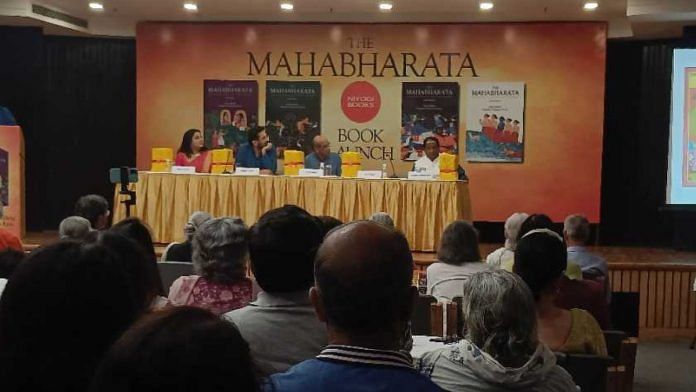New Delhi: What had begun as a conversation on miniature paintings between poet Alok Bhalla and curator Mubarak Hussain culminated in a stunning discovery. A trunk in a dingy room in Udaipur’s City Palace had been sheltering thousands of delicate 17th-century miniature paintings of the Mahabharata. They had been commissioned by Rajput king Maharana Jai Singh of Mewar and painted by Muslim court painter Allah Baksh between 1680 and 1698.
“In a country where Muslims are being lynched, seen as the other, it is a very important representation that it was Allah Baksh who [made] the paintings. Those who claim to be guardians of culture, what do they know of it?” asked professor Sudhir Chandra, who, too, was a part of the discussion. Hussain, Bhalla, and poet Chandra Prakash Deval sifted through over 4,000 miniature paintings to launch The Mahabharata: Mewari Miniature Paintings (1680–1698), a collection of nearly 2,000 paintings in four volumes.
Bhalla and Deval are on a journey to revive India’s artistic identity that isn’t based on religion but on art by shedding light on Baksh’s contribution to the country’s rich history of miniature paintings.
In The Mahabharata by Baksh, they highlight how literature undergoes constant reinterpretation through centuries and millennia.
“For both the poet [Vyasa] and the painter, the Mahabharata is neither a nationalist chronicle of war that conflates heroic individualism with divinity nor a self-endorsing and self-approving Dharma book with a trivial moral tag about doing one’s duty dispassionately. Nor [is it] a philosopher’s conundrum that fails to resolve moral ambiguities,” said Bhalla at the launch of the volumes at Delhi’s India International Centre (IIC).
In that context, an epic like the Mahabharata, which is often reduced to a treatise on war and victory, is a “plea for a more responsible way of becoming a Dharma-being,” write Bhalla and Deval in the preface to the book.
For Deval, the paintings highlight how ancient India, viewed as ‘backward’ through the Western lens, was actually much ahead of its time. As he translated verses from the Mahabharata illustrated in Baksh’s paintings and set them into a narrative, Deval said he realised the diversity of the Indian culture and the importance of a text.
“A 300-year-old text, this (Baksh’s illustrations) is not a Sanskrit Mahabharata but a Rajasthani one, not painted by a Muslim but a proponent of the Mewari school of thought, in such a manner that when you see the paintings, you visualise Mewari culture in its entirety,” he added.
Also read: Kathak, Odissi meets academia and India’s courtesan history is rescued from footnotes
Discovery of the paintings
The miniature paintings were wrapped neatly in muslin.
When Bhalla first laid his eyes on Baksh’s art, he had a once-in-a-lifetime experience. “I thought these are some of the most beautiful things I had seen in the history of miniature painting and they should be known,” said Bhalla. At the time of discovery, they didn’t even know the artist behind the art.
The poet spent the following few days photographing the miniature paintings. But the narrative didn’t make sense—some pieces of the puzzle seemed to be missing. Bhalla and Deval then found the paintings in the Ahar Museum in Udaipur and the City Palace in Jaipur, where they were securely placed in a glass-topped case.
It took months for Bhalla and Deval to organise the paintings in chronological order. While sifting through this treasure trove, they noticed that the painting style, while distinct, was similar to Baksh’s unique style. The artist had also painted every shloka of the Gita, which Bhalla and Deval had curated and published in The Gita: Mewari Miniature Painting (1680-1698) in 2019.
While trying to photograph a miniature painting that sat in its glass-topped case, they spotted an inconspicuous signature reading ‘Allah Baksh’. “That is how we knew we were on the right track. What this man had done was astonishing,” Bhalla said.
Historian and writer Swapna Liddle, who attended the launch along with other scholars such as Sudhir Chandra and Geetanjali Shree, described the works as “wonderful treasures”.
To Liddle, paintings make the text more accessible. “Look at our temples. Stories then came in the form of carved panels for those who couldn’t read,” she said.
Also read: It’s the Merchants of Marwar who gave a new meaning to being Hindu—before the…
Art beyond religion
There are broader strokes to discovering paintings—the goal is to preserve a country’s artistic heritage and traditions. Art historian Naman Ahuja and IIC convenor Shyam Saran pointed out how many of these traditions travelled across the world and even reinterpreted in many places.
Saran recalled a play he watched in Indonesia where a Muslim was portraying the character of Hanuman, a much-revered figure from the Ramayana in the country. Saran had even seen the actor meditating before an idol when the play was about to begin. For him, it was an example of how art goes beyond socially constructed ethics.
The Mewari tradition is significant because it was the only school of art that resisted ‘Mughalisation’ and yet incorporated it. The resistance was a political act manifested through art, according to Saran.
“There is a need to preserve this for generations to come. A good political order always locates the library and the art museum at the centre of its formation,” Bhalla added.
(Edited by Humra Laeeq)



